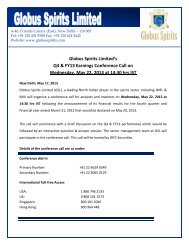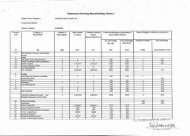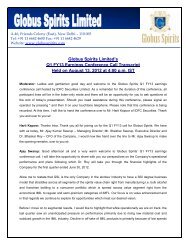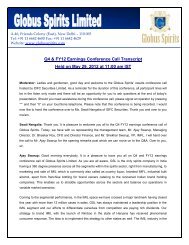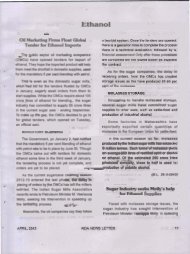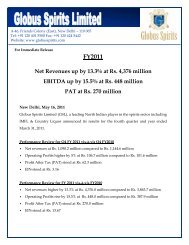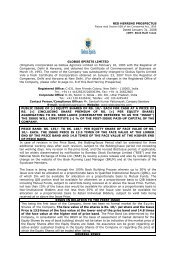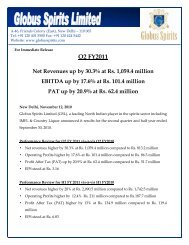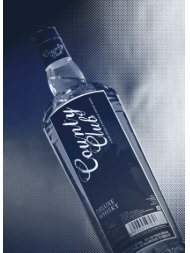- Page 1 and 2:
RED HERRING PROSPECTUS Please read
- Page 3 and 4:
TABLE OF CONTENTS SECTION TITLE PAG
- Page 5 and 6:
Chatrath & Co., Chartered Accountan
- Page 7 and 8:
Margin Amount Memorandum of Associa
- Page 9 and 10:
Company/Industry Related Terms/Tech
- Page 11 and 12:
NRE Account Non Resident External A
- Page 13 and 14:
• Company’s ability to successf
- Page 15 and 16:
The Company constantly endeavours t
- Page 17 and 18:
The Company has reported a net nega
- Page 19 and 20:
the Excise and liquor sourcing poli
- Page 21 and 22:
Writ Petitions related to notificat
- Page 23 and 24:
Northern India Alcohol Sales Pvt. L
- Page 25 and 26:
8. Dependence on agri products Mana
- Page 27 and 28:
l. In addition to the BRLMs, the Co
- Page 29 and 30:
enforced prohibition in 1996, but h
- Page 31 and 32:
THE ISSUE Equity Shares offered: Fr
- Page 33 and 34:
Particulars As on 31.03.2005 31.03.
- Page 35 and 36:
Particulars For the Year/Period End
- Page 37 and 38:
BOARD OF DIRECTORS Name of the Dire
- Page 39 and 40:
Jawahar Vyapar Bhawan, 14th Floor 1
- Page 41 and 42: STATEMENT OF INTER SE ALLOCATION OF
- Page 43 and 44: The grading is however, constrained
- Page 45 and 46: Industry Outlook & Prospects The do
- Page 47 and 48: on a proportionate basis. For furth
- Page 49 and 50: CAPITAL STRUCTURE OF THE COMPANY Sh
- Page 51 and 52: others # 17.4.1995 $ 2,11,640 10 47
- Page 53 and 54: 1.11.1994 Acquisition 18,75,000 10
- Page 55 and 56: Category Code Category of Sharehold
- Page 57 and 58: 8. Mr. Ashok Kumar 33 0.0003 9. Mr.
- Page 59 and 60: OBJECTS OF THE ISSUE The Company pr
- Page 61 and 62: In case of variations in the actual
- Page 63 and 64: 1. Plant and Machinery for 35 KLPD
- Page 65 and 66: Taxes & Duties 127.00 Total 918.00
- Page 67 and 68: Franchise Fees - - - 4.00 Bond Fees
- Page 69 and 70: Mass Media options: • Hoardings 3
- Page 71 and 72: Alcobrew has vide its letter dated
- Page 73 and 74: K GENERAL CORPORATE PURPOSES: The l
- Page 75 and 76: FUNDS DEPLOYED As per the certifica
- Page 77 and 78: Terms of Payment Margin Amount empl
- Page 79 and 80: BASIS FOR ISSUE PRICE The Issue Pri
- Page 81 and 82: Note: The average return on net wor
- Page 83 and 84: STATEMENT OF TAX BENEFITS TAX BENEF
- Page 85 and 86: According to section 10(38) of the
- Page 87 and 88: As per the provisions of Section 11
- Page 89 and 90: Tax. However, the aforesaid income
- Page 91: SECTION IV: ABOUT THE ISSUER COMPAN
- Page 95 and 96: Government Policy & Regulations The
- Page 97 and 98: • Scotch rose by 7.0%. Scotch bra
- Page 99 and 100: substantial market share to India s
- Page 101 and 102: As the Company is increasing its In
- Page 103 and 104: Higher level of instrumentation has
- Page 105 and 106: II. ORDERS ALREADY PLACED: Sl. No 1
- Page 107 and 108: Engineering, Plot No. 65, Bhagwati
- Page 109 and 110: 2 nd Stage (Bio-composting) The was
- Page 111 and 112: converts the slurry into a hydrated
- Page 114 and 115: FLOW CHART OF FINISHING GOODS Recti
- Page 116 and 117: The availability of grain particula
- Page 118 and 119: Domestic - 10 KL Per Day TOTAL - 14
- Page 120 and 121: Power Generation Present Requiremen
- Page 122 and 123: The Spent Wash generated from disti
- Page 124 and 125: • White Lace Duet Gin GR 8 Times
- Page 126 and 127: Indian IMFL Industry has undergone
- Page 128 and 129: Certificate dated 23 rd January 200
- Page 130 and 131: 6. Manufacturing Agreement Parties:
- Page 132 and 133: its distinct identity in the Countr
- Page 134 and 135: PROPERTY A. Properties owned by the
- Page 136 and 137: Date of Agreement: 25.3.1995 vide D
- Page 138 and 139: Date of Agreement: 12.1.1995 vide D
- Page 140 and 141: 27. M/s Globus Agronics Limited Dat
- Page 142 and 143:
Parties Sub-Lessor Associated Disti
- Page 144 and 145:
Class 33 (Thirty Three) Applicant G
- Page 146 and 147:
Sr. No Mark Registration Number Cla
- Page 148 and 149:
BRIEF HISTORY AND OTHER CORPORATE M
- Page 150 and 151:
22.08.1995 • Change in Authorised
- Page 152 and 153:
DIN: 00769308 01.08.2009) Term: 3 y
- Page 154 and 155:
Limited in 1983 and later promoted
- Page 156 and 157:
Industrial Engineer where he was re
- Page 158 and 159:
If at any time the director ceases
- Page 160 and 161:
CORPORATE GOVERNANCE CORPORATE GOVE
- Page 162 and 163:
1. To scrutinize the Share transfer
- Page 164 and 165:
Further, the Directors are also int
- Page 166 and 167:
Chart 1: BEHROR UNIT, RAJASTHAN 139
- Page 168 and 169:
141
- Page 170 and 171:
joined Radico Khaitan Limited in 19
- Page 172 and 173:
PROMOTERS Mr. Ajay Kumar Swarup and
- Page 174 and 175:
Sl. No. Name of Shareholder No. of
- Page 176 and 177:
Related Party Transactions For deta
- Page 178 and 179:
estatements and regroupings as cons
- Page 180 and 181:
ANNEXURE-II STATEMENT OF PROFIT & L
- Page 182 and 183:
At each balance sheet an assessment
- Page 184 and 185:
Particulars Key Management Personal
- Page 186 and 187:
Particulars Associates Key Manageme
- Page 188 and 189:
ENA BL 44.93 1477.37 14.06 1080.81
- Page 190 and 191:
AS ON PARTICULARS 31-Mar-05 31-Mar-
- Page 192 and 193:
guaranteed by Sh. Madhav K. Swarup
- Page 194 and 195:
ANNEXURE-XI STATEMENT OF CURRENT LI
- Page 196 and 197:
Note: ** Information pertaining to
- Page 198 and 199:
EXISTING BORROWING FACILITIES The C
- Page 200 and 201:
Prepayment Charges: 2% of the Prepa
- Page 202 and 203:
losses and deferred expenditure not
- Page 204 and 205:
There are no defaults in meeting an
- Page 206 and 207:
3. Networth means aggregate of valu
- Page 208 and 209:
SHAREHOLDING Sl. No. Name of Shareh
- Page 210 and 211:
horticulture and agriculture in all
- Page 212 and 213:
There are no defaults in meeting an
- Page 214 and 215:
Ajay Swarup) together hold 100% sha
- Page 216 and 217:
3. Networth means aggregate of valu
- Page 218 and 219:
MANAGEMENT’S DISCUSSION AND ANALY
- Page 220 and 221:
Interest & Finance Charge 40.29 53.
- Page 222 and 223:
Interest and Finance Expenses The i
- Page 224 and 225:
Similarly, for consumers like fuel
- Page 226 and 227:
(b). Recovery Suits 1. Globus Agron
- Page 228 and 229:
SB. Civil Writ Petition No. 3454 of
- Page 230 and 231:
ecovery of the amount of cess payab
- Page 232 and 233:
New-Delhi. which on account of any
- Page 234 and 235:
(Prevention & Control of Pollution)
- Page 236 and 237:
Whisky (Own Brand) and Country Liqu
- Page 238 and 239:
Transformer and 11 KV Line Validity
- Page 240 and 241:
Valid until cancelled. Government o
- Page 242 and 243:
4 - Distributable profits have been
- Page 244 and 245:
The filing of the Red Herring Prosp
- Page 246 and 247:
person consequent to or in connecti
- Page 248 and 249:
Others The total fees payable to th
- Page 250 and 251:
The auditors of the Company are app
- Page 252 and 253:
• Right to receive surplus on liq
- Page 254 and 255:
Application by Eligible NRIs/FIIs r
- Page 256 and 257:
Market Lot Share Who can apply ** E
- Page 258 and 259:
ISSUE PROCEDURE Principal Terms And
- Page 260 and 261:
one Bid in the ASBA Bid cum Applica
- Page 262 and 263:
exchange in India only in favour of
- Page 264 and 265:
Bidders are advised to ensure that
- Page 266 and 267:
2. In accordance with the SEBI guid
- Page 268 and 269:
The Bidders may note that the Escro
- Page 270 and 271:
) The book gets built up at various
- Page 272 and 273:
Filing of the Red Herring Prospectu
- Page 274 and 275:
c. Do not Bid on another Bid-cum-Ap
- Page 276 and 277:
The Company in its absolute discret
- Page 278 and 279:
In case of Bids made by Insurance C
- Page 280 and 281:
c) In case of Resident QIB Bidders:
- Page 282 and 283:
application received and a photo ma
- Page 284 and 285:
Herring Prospectus and as per the i
- Page 286 and 287:
have submitted Bids at or above the
- Page 288 and 289:
EQUITY SHARES IN DEMATERIALIZED FOR
- Page 290 and 291:
the disclosed manner and/ or demat
- Page 292 and 293:
The Company will provide adequate f
- Page 294 and 295:
Our Company, in consultation with t
- Page 296 and 297:
• The BRLMs shall ensure that ade
- Page 298 and 299:
eceived the ASBA in a physical or e
- Page 300 and 301:
ank account and not to the Bankers
- Page 302 and 303:
In case of ASBA Bids made pursuant
- Page 304 and 305:
SECTION IX MAIN PROVISIONS OF THE A
- Page 306 and 307:
CAPITAL AND INCREASE AND REDUCTION
- Page 308 and 309:
to accept the shares offered, the B
- Page 310 and 311:
in lieu thereof, to the satisfactio
- Page 312 and 313:
30. A call may be revoked or postpo
- Page 314 and 315:
46. The Board may, at anytime befor
- Page 316 and 317:
The Board may, at any time, give no
- Page 318 and 319:
10. The Register and Index of benef
- Page 320 and 321:
that in the case of an Annual Gener
- Page 322 and 323:
committee or other legal guardian;
- Page 324 and 325:
DIRECTORS (8) The book containing t
- Page 326 and 327:
notwithstanding fixed by the Articl
- Page 328 and 329:
(a) a director in such company, and
- Page 330 and 331:
the Board may by resolution vest in
- Page 332 and 333:
(a) (b) the names of the Directors
- Page 334 and 335:
mortgage may contain a power of sal
- Page 336 and 337:
(b) The Company shall also be at, l
- Page 338 and 339:
174. For the purpose of giving effe
- Page 340 and 341:
Register of Members, shall have bee
- Page 342 and 343:
Documents for Inspection i) Memoran
- Page 344:
DECLARATION All the relevant provis





